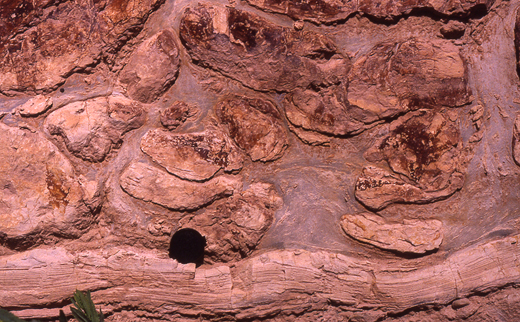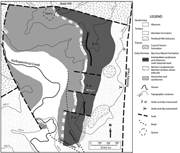The upper part of the Bacchus Marsh Formation contains conulariids, sparse plant macrofossils and a Stage 2 palynoflora (in the terminology of Price 1993; C. Foster in O´Brien et al. 2003) that indicate a late Sakmarian (Early Permian) age (Warne et al. 2003). On this basis, the Bacchus Marsh Formation flora is significant, since it represents one of the oldest Permian macrofloras in Australia and provides insights into the character of the emerging glossopterid flora immediately following the retreat of the gondwanan ice sheet.
Plant macrofossils (mostly glossopterid leaves and axis impressions) occur sporadically in the massive to laminated medium- to coarse-grained sandy fluvial facies at several localities (the best known being Korkuperrimul Creek and Morton´s Quarry at Bald Hill) and these leaves have been studied by several workers for over a century (e.g. McCoy, 1875; Rigby & Chandra, 1990). Given the coarseness of the lithology, most leaf fossils are poorly preserved. The finer details of cross-connections in the secondary venation are difficult to discern. Most of the leaves have just a loose aggregation of veins in the centre of the leaf rather than a well-defined midrib and are, thus, assigned to several Gangamopteris species based on differences in gross shape and the degree of arching in the secondary veins. Apart from glossopterids, the only confidently identified plant remains from the Bacchus Marsh Formation are sphenophyte (horsetail) stems.
The SwedishMuseum of Natural History hosts a small collection (18 slabs) of plant fossils from the Bacchus Marsh Sandstone. These were obtained by exchange of specimens with other museums and material recovered by individual collectors beginning with N.O. Holst in 1897 and finishing with B. Lundblad in 1981.
References
McCoy, F., 1875. Prodromus of the Palaeontology of Victoria. Figures and descriptions of the Victorian organic remains, Decade 2. Geological Survey of Victoria, Melbourne.
O'Brien, P.E., 1989 Subglacial sedimentary features in Late Palaeozoic sedimentary rocks, central Victoria ,Australia. Sedimentary Geology 61, 1-15.
O´Brien, P.E., 1996. Permian glacial sediments of the Bacchus Marsh area. Excursion guide, 1996 Selwyn Memorial Symposium, Geological Society of Australia (Victorian Division), 30 pp.
O´Brien, P.E., Bowen, R.L., Thomas, G.A., Craig, M.A. & Holdgate, G.R., 2003. Permian. In Geology of Victoria, W.D. Birch, ed., Geological Society of Australia Special Publication 23, 195-215.
Price, P.L., 1983. A Permian palynostratigraphy for Queensland. In Proceedings of the Symposium on the Permian Geology of Queensland. Geological Society ofAustralia ,QueenslandDivision, Brisbane, 155-212.
Rigby, J.F. & Chandra, S., 1990. Revision of the Permian Gondwanan flora from Bacchus Marsh, Victoria. In Proceedings of the 3rd International Organisation of Palaeobotany Conference, J.G. Douglas & D.C. Christophel, eds, International Organisation of Palaeobotany Publication 2, 107-113.
Warne, M.T. et al., 2003. Palaeontology. In Geology of Victoria, W.D. Birch, ed., Geological Society of Australia Special Publication 23, 605-654.
Webb, J.A. & Spence, E., 2008. Glaciomarine Early Permian strata at Bacchus Marsh, Central Victoria. The final phase of late Palaeozoic glaciation in southern Australia. Proceedings of the Royal Society of Victoria 120, 373-388.

Soft-sediment deformation structures in glaciomarine sediments of the lower Bacchus Marsh Formation at Werribee Gorge, near Bacchus Marsh. Photo: S. McLoughlin 1996.




